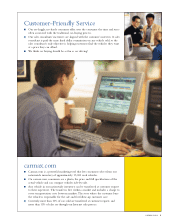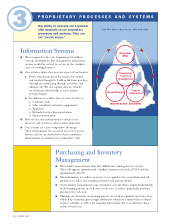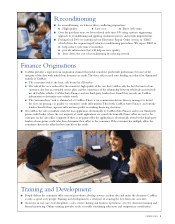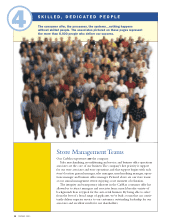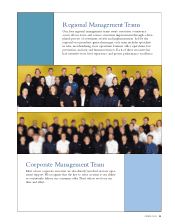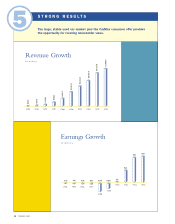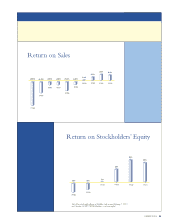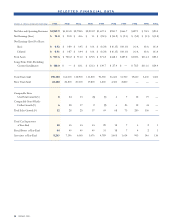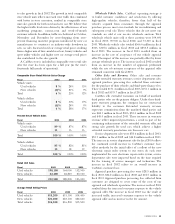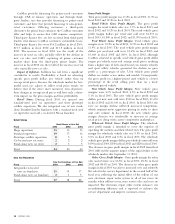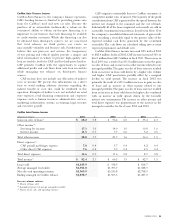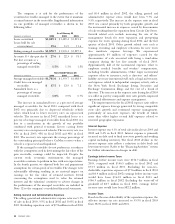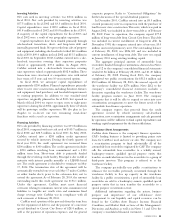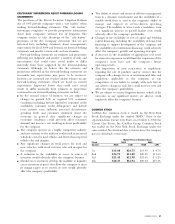CarMax 2003 Annual Report Download - page 19
Download and view the complete annual report
Please find page 19 of the 2003 CarMax annual report below. You can navigate through the pages in the report by either clicking on the pages listed below, or by using the keyword search tool below to find specific information within the annual report.
CARMAX 2003 17
In this discussion, “we,” “our,” “CarMax,” “CarMax, Inc.” and
“the company” refer to CarMax, Inc. and its wholly owned
subsidiaries, unless the context requires otherwise. Amounts and
percents in the tables may not total due to rounding.
BACKGROUND
CarMax was formerly a wholly owned subsidiary of Circuit
City Stores, Inc. (“Circuit City Stores”). On September 10,
2002, the Circuit City Stores shareholders, which included
Circuit City Stores, Inc.–Circuit City Group Common Stock
shareholders and Circuit City Stores, Inc.–CarMax Group
Common Stock shareholders, approved the separation of the
CarMax business from Circuit City Stores, and the Circuit
City Stores board of directors authorized the redemption of
the CarMax Group Common Stock and the distribution of
CarMax, Inc. common stock to effect the separation. The
separation was effective October 1, 2002. Each outstanding
share of CarMax Group Common Stock was redeemed in
exchange for one share of new CarMax, Inc. common stock.
In addition, each holder of Circuit City Group Common
Stock received, as a tax-free distribution, a 0.313879 share of
CarMax, Inc. common stock for each share of Circuit City
Group Common Stock owned as of September 16, 2002, the
record date for the distribution. As a result of the separation,
all of the businesses, assets and liabilities of the CarMax Group
are now held in CarMax, Inc., an independent, separately
traded public company.
CRITICAL ACCOUNTING POLICIES
In Management’s Discussion and Analysis, we discuss the
results of operations and financial condition as reflected in
the company’s consolidated financial statements, which have
been prepared in accordance with accounting principles
generally accepted in the United States of America.
Preparation of financial statements requires management to
make estimates and assumptions affecting the reported
amounts of assets, liabilities, revenues and expenses and the
disclosures of contingent assets and liabilities. We use our
historical experience and other relevant factors when
developing our estimates and assumptions. We continually
evaluate these estimates and assumptions. Note 2 to the
company’s consolidated financial statements includes a
discussion of significant accounting policies.The accounting
policies discussed below are the ones we consider critical to
an understanding of the company’s consolidated financial
statements because their application places the most
significant demands on our judgment. Our financial results
might have been different if different assumptions had been
used or other conditions had prevailed.
Calculation of the Fair Value of Retained Interests in
Securitization Transactions
The company uses a securitization program to fund
substantially all of the automobile loan receivables originated
by its finance operation, CarMax Auto Finance (“CAF”).The
fair value of retained interests in securitization transactions
includes the present value of the expected residual cash flows
generated by the securitized receivables, the restricted cash on
deposit in various reserve accounts and an undivided
ownership interest in the receivables securitized through a
warehouse facility.The present value of the expected residual
cash flows generated by the securitized receivables is
determined by estimating the future cash flows using
management’s projections of key factors, such as finance
charge income, default rates, prepayment rates and discount
rates appropriate for the type of asset and risk. These
projections are derived from historical experience, projected
economic trends and anticipated interest rates.Adjustments to
one or more of these projections may have a material impact
on the fair value of retained interests.The fair value of retained
interests may be affected by external factors, such as changes
in the behavior patterns of customers, changes in the strength
of the economy and developments in the interest rate markets.
Note 2(C) to the company’s consolidated financial statements
includes a discussion of accounting policies related to
securitizations. Note 12 to the company’s consolidated
financial statements includes a discussion of securitizations.
Revenue Recognition
We recognize revenue when the earnings process is complete,
generally either at the time of sale to a customer or upon
delivery to a customer.The majority of our revenue is from the
sales of used and new vehicles. We recognize vehicle revenue
when a sales contract has been executed and the vehicle has
been delivered, net of a reserve for returns.A reserve for vehicle
returns is recorded based on historical experience and trends.
The estimated reserve for these returns could be affected if
future occurrences differ from historical averages.
The company also sells extended warranties on behalf of
unrelated third parties to customers who purchase a vehicle.
Because these third parties are the primary obligors under
these contracts, the company recognizes extended warranty
revenue at the time of the sale, net of a provision for estimated
warranty returns. The estimates for returns are based on
historical experience and trends.
Defined Benefit Retirement Plans
The plan obligations and related assets of the company’s
defined benefit retirement plans are presented in Note 8 to
the company’s consolidated financial statements. Plan assets,
which consist primarily of marketable equity and debt
instruments, are valued using market quotations. Plan
obligations and the annual pension expense are determined
by independent actuaries using a number of assumptions
provided by the company. Key assumptions in measuring the
plan obligations include the discount rate, the rate of salary
increases and the estimated future return on plan assets. In
determining the discount rate, the company utilizes the yield
MANAGEMENT’S DISCUSSION AND ANALYSIS


